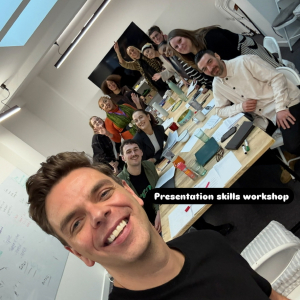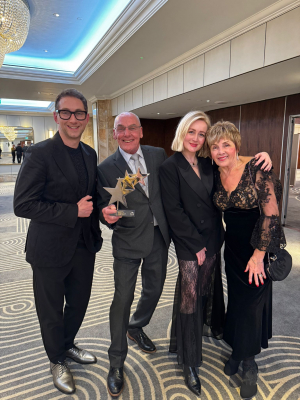-
.
Gareth Davies
What Are the 5 P's of Presentation Skills?
What Are the 5 P's of Presentation Skills?
Presentation skills are essential for effective communication, whether in business, education, or public speaking. To deliver a compelling and engaging presentation, mastering the 5 P's of Presentation Skills is crucial.
These five elements - Planning, Preparation, Practice, Performance, and Presence - help ensure that your message is clear, impactful, and well-received.
So here’s some tips and tricks that will help you:
1. Planning
The foundation of any great presentation starts with planning. This involves understanding your audience, defining your key message, and structuring your content in a logical and engaging way. Effective planning includes:
Identifying your audience's needs and expectations
Setting clear objectives for your presentation
Organizing your content with a strong introduction, body, and conclusion
Choosing the right visual aids and supporting materials
And finding your own voice and developing your own style – don’t just go into ‘presentation mode’ think of this as an exciting opportunity to engage or entertain your audience.
Without proper planning, your presentation may lack coherence and fail to engage your audience.
2. Preparation
Once you have a plan, the next step is preparation. This involves gathering resources, creating slides or other visual aids, and ensuring all technical aspects are in place. Key aspects of preparation include:
Designing visually appealing slides with minimal text and high-impact visuals – but ask yourself – do you really need them? Keep them snappy. Very little text. And on brand to the business you represent.
Create a Running Order – a high level overview of your presentation that is split up into timed segments. Then write a script…more on that in a bit.
3. Practice
No matter how experienced you are, practice is essential to delivering a smooth and confident presentation. Practicing helps refine your delivery, improve timing, and reduce nervousness. Effective ways to practice include:
Writing a script. Practice with it. Then sub it back onto cards.
Rehearsing out loud multiple times – standing up.
Practicing in front of a colleague – ask for feedback.
Work on tone, body language, pace, pauses, light and shade…
The more you practice, the more comfortable and natural your presentation will feel.
4. Performance
When it’s time to deliver, your performance determines how well your audience receives your message. A strong performance involves:
Speaking clearly and confidently – connect from the heart not the head.
Engaging with your audience through eye contact and gestures
Using storytelling and real-life examples to illustrate points – but make they the stories don’t cloud the main takeout.
Enjoy it!
Your energy and enthusiasm will influence how your audience perceives your message, so be sure to bring your best self to the stage.
5. Presence
Your presence is about how you carry yourself and connect with your audience. It involves confidence, authenticity, and the ability to command attention. To enhance your presence:
Maintain good posture and purposeful movement – this is a visual performance so always think of how you want to look and stand.
Adapt to the audience’s reactions and stay flexible – hard to do – but a simple question to re-engage them can help.
And we’ll say it again – enjoy it! It’s a great opportunity personally and professionally.
Conclusion
Mastering the 5 P’s of Presentation Skills - Planning, Preparation, Practice, Performance, and Presence - will help you deliver impactful and engaging presentations. Whether you’re speaking to a small team or a large audience, these principles will enhance your ability to communicate effectively and leave a lasting impression.
By focusing on these essential elements, you can overcome nervousness, improve your delivery, and captivate your audience with confidence and clarity.
For more information on our bespoke presentation skills training programmes visit: https://www.presenterstudio.com/business-presenter-training/presentation-skills-training
Mastering the Art of Presenting to Camera: Media Training Tips for Confidence & Impact
Mastering the Art of Presenting to Camera: Media Training Tips for Confidence & Impact
Presenting to camera can feel intimidating, but with the right techniques, you can own the screen with confidence. Whether you're giving a media interview, recording a corporate video, or hosting a webinar, camera presence is a skill you can master. At The Presenter Studio, we specialize in media training that helps professionals communicate with clarity, confidence, and impact.
Here’s how to present to camera like a pro:
1. Think of the Camera as Your Best Friend
The biggest mistake people make? Seeing the camera as a cold, intimidating lens instead of a trusted friend. Shift your mindset—imagine you're talking to someone who genuinely supports and listens to you.
This simple trick helps with nerves, energy, tone, and pace. When you feel relaxed, your delivery becomes more engaging and natural.
2. Interviews: Who Are You Talking To?
In an interview setting, there are always three people in the conversation:
- The interviewer – the person asking the questions.
- The audience – the viewers at home or online.
- You – the expert delivering the message.
Where Should You Look?
- Looking at the interviewer? This makes the conversation feel intimate and authentic.
- Looking at the camera? This creates a direct connection with your audience, making them feel spoken to personally.
Decide before the interview which approach works best for the format and your message.
3. Don't Shout! The Mic is Doing the Work
A common mistake in presenting to camera is over-projecting. If the camera is far away, you might instinctively raise your voice—but remember, if you’re mic’d up, you don’t need to.
Speak at a natural volume—your mic will capture every word. ✔ Focus on tone and clarity rather than volume. ✔ Avoid sudden changes in pitch that can sound unnatural on playback.
Check out the media training courses we run here: https://www.presenterstudio.com/business-presenter-training/media-training
The Power of the Visual in Public Speaking
The Power of the Visual in Public Speaking: What You Wear, Your Slides & Your Stage Presence
When it comes to public speaking, your words matter—but so does the way you present them. At The Presenter Studio, we know that visual impact plays a crucial role in how your audience perceives and remembers your message. From what you wear to how you use slides, Zoom, and even body movement, every visual element should enhance your authority, confidence, and connection with your audience.
1. What to Wear: Confidence Through Clothing
Your outfit is part of your communication. It should reflect who you are and the message you want to deliver. Clean lines, confident colors, and a look that aligns with your brand can make all the difference.
Examples:
- Steve Jobs (Apple) – His black turtleneck and jeans became iconic, reinforcing his brand’s simplicity and innovation.
- Mark Zuckerberg (Facebook) – His casual hoodie reflected a relaxed, tech-startup culture.
? Tip: Choose colors that boost confidence (blue for trust, red for energy, black for authority) and ensure your outfit looks polished on camera and in person.
2. Slides: Less Is More
Your slides should support your speech, not distract from it. Too much text can overwhelm your audience and take focus away from you. Use them only when they add impact.
Best Practices:
✔ Use one key point per slide ✔ Ditch the bullet points—use images, graphics, or one-liners instead ✔Keep fonts large and legible ✔ Stick to clean, professional design
3. Zoom: The Virtual Stage
With online presentations, your background, shot, and lighting determine how professional and engaging you appear.
Key Factors:
? The Background: Keep it clean, uncluttered, and brand-aligned (no messy rooms!) ? Lighting: Natural light or soft ring lights help you look your best ? Shot Composition: Position your camera at eye level to maintain a natural, engaging connection ? Team Consistency: Ensure your entire team aligns their shots for a professional, unified look
4. Eye Contact: Your Connection Tool
Your eyes convey confidence and authenticity. Whether in person or on camera, maintain eye contact to build trust.
? Tip: If you're presenting virtually, look directly into the camera rather than at the screen.
5. The First Impression: How You Walk On
The way you step onto the stage (or into the frame) sets the tone for your entire presentation. Move with purpose and confidence.
Best Practices:
- Walk on with a smile and open body language
- Take a steady, confident stride
- Stand tall and avoid fidgeting
6. Choreography: Where You Walk and Why
Your movement on stage should feel natural and intentional. Avoid pacing aimlessly—walk with purpose.
How to Move Effectively:
- Move when transitioning topics
- Walk toward your audience to emphasize key points
- Avoid rocking or swaying—it distracts from your message
Next Time You Do a Presentation – Do a Cynthia Erivo
Next Time You Do a Presentation – Do a Cynthia Erivo. Last night, Cynthia Erivo delivered a powerhouse performance at the Academy Awards that had everyone on the edge of their seats. Her voice, her presence, and her sheer authenticity reminded us of one of the most crucial aspects of any performance - whether it’s singing, acting, or speaking: connection.
Watching her perform, it’s clear that there’s so much we can learn from her approach when it comes to speaking and presenting. If you think about it, speaking in front of an audience is much like singing. The principles of connecting with your words, using light and shade, and finding your own unique rhythm apply just as much in the boardroom as they do on stage. Whether you're presenting at work, leading a meeting, or giving a keynote address, it’s time we start thinking about public speaking the same way we think about performance. And who better to learn from than Cynthia Erivo?
1. Connect with the Words. Cynthia Erivo doesn’t just sing; she connects with every word she sings. You can hear it in the way she pours emotion into every lyric, making each one resonate with the audience. When you speak, it’s just as important to connect with your words. Don’t just go through the motions - feel the message you're delivering. A speech isn’t just a list of facts or ideas; it’s a story, a feeling, an experience that you’re sharing with your audience. Whether you're talking about your latest project, presenting a new idea, or giving a speech to inspire others, you need to bring life to your words. Just like Cynthia brings a powerful emotional intensity to her music, bring passion to your presentation. Be invested in what you're saying. People will remember how you made them feel, not just the information you provided.
2. Think Light and Shade. One of the things that made Cynthia’s performance at the Oscars so mesmerizing was her ability to play with light and shade in her voice. She didn’t simply belt out her song; she knew when to soften her delivery, build up to a crescendo, and when to let a pause hang in the air. It was a masterclass in vocal dynamics - and it’s something we can apply to our own speaking. Public speaking, much like singing, isn’t about maintaining a constant tone. To keep your audience engaged, you need to vary your delivery - bring in light and shade. You can change your tone, your pace, and your volume to emphasize key points, add emotion, or give the audience a moment to absorb what you've said. Don't be afraid of pauses; they can be just as powerful as a well-timed sentence. Use silence to create suspense, or to give your listeners time to reflect on what you’ve just shared.
3. Make It Your Own. A key aspect of Cynthia’s performance was how she made the song her own. The Wicked songs are well known – but she’s given us her own personal take on them. While the song may have been written by others, her delivery made it feel deeply personal. The same should be true for your presentations. Too often, we try to emulate other speakers or follow the “correct” way of presenting. But your voice, your message, and your delivery should be uniquely yours. When you step onto the stage - whether it's a literal stage or the metaphorical stage of a conference room - make the presentation your own. Infuse it with your personality, your style, your perspective. If you're nervous, embrace it; use it to fuel your energy. When you are authentic and true to yourself, your audience will be more likely to connect with your message.
4. Perfect Your Stagecraft. Cynthia Erivo's ability to command the stage with grace, power, and poise is undeniable. But it’s not just about having a beautiful voice; it’s about perfecting her stagecraft. Every step, every gesture, every movement was intentional and calculated to enhance the performance. The same goes for your presentation. Stagecraft in speaking isn’t just about where you stand or what you wear; it’s about using your body to complement your words. Stand tall, move with purpose, and use your hands to emphasize key points. Your body language can convey confidence and help engage the audience. Don’t just stand still behind a podium. Move across the stage if you can, make eye contact with different members of your audience, and let your gestures help tell the story you're sharing.
*5. Consider Your Audience and the Stage. Another lesson we can take from Cynthia’s performance is how she fully understands her audience and the stage she is performing on. She adjusted her energy and approach to fit the setting. In the same way, your presentation should be tailored to your audience and the environment you are in. What works in a small meeting might not work in front of a large crowd. Similarly, the way you present in a casual setting may differ from the way you present in a formal conference. Before any presentation, take the time to consider your audience. What do they expect? What do they care about? What tone will resonate with them? And think about the setting—whether it’s a small boardroom, a large auditorium, or even a virtual stage. Adjust your delivery accordingly so that your message lands in the most effective way possible.
6. Embrace Timings, Pace, and Pauses. If there’s one thing Cynthia Erivo excels at, it’s timing. Her ability to pace her performance and hold a note just long enough, creating dramatic pauses and unexpected moments, makes her one of the most riveting performers of our time. When you present, think about the rhythm of your speech. Don’t rush through your points. Embrace pauses. Silence can be powerful—whether it’s a pause for effect, a moment for your audience to reflect, or a way to build suspense. Use timing to your advantage to emphasize your key points. Pacing is also essential. If you talk too quickly, your audience may struggle to keep up; if you drag out your words too much, you risk losing their attention. Practice speaking at a comfortable pace, and vary the speed depending on what you're trying to convey. If you want to emphasize a point, slow down. If you're telling an exciting story or building up to something, speed up a little to bring energy and excitement to the room.
In Conclusion. Cynthia Erivo’s unforgettable performance at the Academy Awards was a masterclass in connection, timing, and authenticity. As we watch her command the stage, we can’t help but draw parallels to the art of public speaking. Just as she connects with every word and uses light and shade to create an emotional journey, we must learn to connect with our words, master our delivery, and tailor our performances for our audience.
The next time you prepare for a presentation, channel a bit of Cynthia Erivo's energy. Don’t just speak—perform. Connect with your words, find your rhythm, embrace pauses, and most importantly, make it your own. When you step onto the stage, remember that speaking is an art—and with the right approach, you too can deliver a performance that leaves a lasting impression.
For more about our presentation skills training programmes visit: https://www.presenterstudio.com/business-presenter-training/presentation-skills-training
Top 10 Proven Tips to Master Your Presentation Skills
Top 10 Proven Tips to Master Your Presentation Skills:
Presentations are a critical skill in both personal and professional settings. Whether you're presenting in a boardroom, at a conference, or in front of a classroom, the ability to effectively communicate your ideas can make a significant difference in your success. However, mastering presentation skills isn't something that happens overnight. It requires practice, reflection, and an understanding of various techniques. In this article, we’ll explore ten proven tips to help you enhance your presentation skills and truly engage your audience.
1. Develop Your Own Style. The most effective presenters are not the ones who mimic someone else’s delivery. They are the ones who have developed their own unique style. This is important because your style should reflect who you are and make you feel comfortable while presenting. Whether you're energetic and lively or calm and composed, your style should align with your personality and strengths. A presenter who is authentic is much more engaging and relatable. Trying to adopt someone else’s persona often feels forced and can distract both you and the audience from the message you're trying to convey. Take time to explore different methods of presenting. Once you discover your authentic presentation style, you’ll naturally feel more at ease and confident, which will resonate with your audience.
2. Make Sure Your Style Works with Your Brand. Your presentation style should not only reflect your personality but also fit within the context of your personal or professional brand. Whether you're an entrepreneur, a corporate leader, or a teacher, your presentation style communicates your values and enhances your credibility. For example, if you’re a startup founder pitching an innovative idea, you might opt for an enthusiastic, fast-paced delivery. On the other hand, if you're presenting a corporate strategy to senior executives, you may need to adopt a more formal and measured tone. It’s important to understand that your presentation style is an extension of your personal or company brand. It helps shape how your audience perceives you. Ask yourself: "Does my presentation style align with the message I’m trying to communicate and the brand I want to project?" Consistency is key. If your style contradicts your brand, it can cause confusion and undermine your credibility. So, before presenting, reflect on what you want your audience to remember about you and ensure your style supports that goal.
3. Keep It Short and Sweet. We live in an era of information overload, and people’s attention spans are shorter than ever. If you’re presenting a long, drawn-out speech, your audience will likely tune out. One of the most effective ways to keep your audience engaged is to keep your presentation short and focused. Condense your message to its core points, ensuring that everything you say serves a clear purpose. When preparing your presentation, ask yourself, "What are the key takeaways I want my audience to remember?" Once you’ve identified these core ideas, structure your presentation around them and avoid adding unnecessary filler content. Be concise, and respect your audience’s time by sticking to your allotted time limit. If you make your presentation clear and to the point, you’ll leave your audience with a more lasting impression.
4. Write a Script. Although some people may find it restrictive, writing a script for your presentation can help organize your thoughts and make sure you don't miss important details. A script can be particularly helpful when preparing for more formal presentations, such as business pitches, lectures, or public speaking engagements. When you write a script, you have the opportunity to choose your words carefully, ensuring that every phrase aligns with your main message. However, a script shouldn’t be a word-for-word memorization. Rather, it should serve as a guide. Once you’ve written your script, practice delivering it aloud until you’re comfortable with the flow of words and transitions. Even if you don’t stick to the script exactly, it will give you a solid foundation and make your delivery feel more polished. Another great advantage of writing a script is that it allows you to test different approaches. If one part of your presentation doesn’t feel right, you can rework it until it sounds natural and effective. Think of the script as a tool to refine your ideas, rather than a rigid rulebook.
5. Eye Contact Is the Best Way to Cheat Confidence. One of the most powerful ways to convey confidence during a presentation is through eye contact. Maintaining good eye contact helps establish trust and creates a sense of connection with your audience. It also signals that you are engaged and present in the moment. Eye contact doesn’t just help others see that you’re confident; it also helps you feel confident. If you struggle with nervousness, try focusing on a few friendly faces in the crowd and make sure to connect with each person briefly. By doing so, you'll appear more confident than you feel, and the audience will respond positively. It’s important to avoid looking at the floor, ceiling, or your notes for extended periods of time, as this can make you seem disconnected or unsure of yourself. While making eye contact is important, be mindful of overdoing it. Staring intensely at one person for the entire presentation can make them uncomfortable. Instead, try to rotate your gaze around the room to ensure you engage with everyone in the audience.
6. Find Light and Shade. When delivering a presentation, the emotional tone of your voice plays a crucial role in maintaining engagement. Just like light and shade create depth in visual art, varying your tone of voice adds richness and dimension to your message. If you speak in a monotonous tone, your audience may lose interest quickly. To keep people engaged, use changes in your voice to emphasize key points, highlight important ideas, and convey emotions effectively. For example, when you’re about to make an important point, slow down your speech and lower your tone. This builds anticipation and draws your audience’s attention. Conversely, if you're discussing something exciting or energizing, raise your voice slightly and quicken your pace. Playing with the dynamics of your voice will keep your audience on their toes, and they’ll be more likely to remember what you said. In addition to vocal tone, the use of pauses can create "shade" in your presentation. Pausing at strategic moments not only gives you time to collect your thoughts but also gives your audience time to process the information. A well-placed pause can add emphasis to a point and keep your listeners engaged.
7. Engage Your Audience with Stories. One of the most effective ways to connect with your audience is by telling stories. People remember stories far better than they remember statistics or data points. A well-told story helps humanize your presentation and makes your message more relatable. You can use stories to illustrate key concepts or to demonstrate real-world applications of your ideas. When telling a story, make sure it is relevant to your presentation. Your audience will respond positively to anecdotes that help clarify or support your main message. Stories also provide an opportunity to show vulnerability and connect emotionally with your listeners, which builds rapport and trust. A great way to integrate storytelling is to start your presentation with a compelling personal story or a case study that sets the tone for the entire presentation. This approach hooks your audience from the beginning and sets up your key messages in a memorable way.
8. Master Non-Verbal Communication. While your words are crucial, your body language is just as important in conveying your message. Your non-verbal communication can reinforce or undermine what you're saying, so it’s essential to be mindful of how you present yourself physically. Use purposeful gestures to emphasize important points and to engage with your audience. Avoid crossing your arms, which can make you seem closed off or defensive. Instead, keep your body open, stand tall, and move naturally around the stage or area where you're presenting. Use your face and body to communicate as much as your words do.
9. Rehearse Like a Pro. There’s no substitute for practice when it comes to perfecting your presentation skills. Rehearse your presentation several times before the actual event. The more you practice, the more comfortable you’ll feel, and the better your delivery will be. Rehearse in front of a mirror, record yourself, or present to a friend or colleague. This will help you spot areas where you might be tripping up or where you can improve. When rehearsing, pay attention to your timing. Make sure your presentation fits within the time limit, and practice pacing yourself so you don’t rush through key points. You’ll also want to rehearse your transitions between slides or topics, ensuring the flow of your presentation is smooth and seamless.
10. Handle Questions with Confidence. One of the most nerve-wracking parts of any presentation is the Q&A session. However, how you handle questions can be just as important as your actual presentation. Prepare for potential questions ahead of time by anticipating what your audience might ask. This will help you feel more prepared and less anxious. When responding to questions, listen carefully and give thoughtful, concise answers. If you don’t know the answer to a question, don’t be afraid to admit it. Honesty and humility will earn you respect from your audience. You can always offer to follow up later with more information. During the Q&A session, maintain the same level of engagement as during your presentation. This shows that you are confident in your message and willing to engage with your audience in a meaningful way.
Conclusion. Mastering your presentation skills takes time and practice, but with these ten proven tips, you can enhance your abilities and leave a lasting impression on your audience. Developing your own style, keeping your presentation concise, engaging with eye contact and stories, and rehearsing thoroughly will ensure that you’re well-prepared to deliver a compelling message. By focusing on both the verbal and non-verbal aspects of communication, you’ll be able to connect with your audience and convey your ideas with confidence.
For help with your presentations check out the presentation training courses we offer here at The Presenter Studio: https://www.presenterstudio.com/business-presenter-training/presentation-skills-training
How to Become a Good Public Speaker with No Experience
Public speaking can feel daunting, especially if you’ve never stepped onto a stage or addressed a crowd before.
The good news? You don’t need prior experience to become a confident and compelling speaker. With dedication, practice, and a few clever strategies, anyone can master the art of holding an audience’s attention.
Below, The Presenter Studio team shares some tips to help you on your journey to becoming a great public speaker, even if you’re starting from scratch.
Start off small
If the idea of speaking in front of a large group makes your palms sweat, don’t worry, you don’t have to dive straight into a keynote address. Begin with small, low-pressure settings.
Chat with a few friends or family members and ask for their feedback. Join a local club or group, like a book club or community meet-up, where you can share your thoughts in a relaxed environment. These baby steps will help you get comfortable with expressing yourself out loud, laying the groundwork for bigger audiences later.
Develop a structure
Good public speaking isn’t about winging it, but about structure.
Even without experience, you can craft a solid talk by following a simple formula: an engaging opening, a clear middle with key points, and a memorable close.
Start with a story, question, or surprising fact to hook your listeners. Then, organise your main ideas into three digestible points. People tend to remember things in threes.
Wrap up with a call to action or a thought-provoking takeaway. Practice this framework with everyday topics, like explaining a recipe or sharing a film review, to build your skills.
Learn from the pros
You don’t need to reinvent the wheel.
Watch TED Talks, stand-up comedy, or even local speakers at events to see what works. Pay attention to how they use pauses, vary their tone, and connect with the audience.
You’re not copying their style, think of it as gathering inspiration.
Note what grabs your attention and try mimicking those techniques in your own practice sessions. Over time, you’ll find your own voice while borrowing from the best.
Practice
There’s no shortcut here: practice is your golden ticket.
Record yourself speaking on your phone and play it back. It might feel awkward at first, but you’ll spot areas to improve, like cutting out “ums” or slowing your pace.
Try rehearsing in front of a mirror to work on your posture and gestures.
If you’re feeling brave, ask a trusted friend to listen and give honest feedback. The more you practice, the more natural it’ll feel when the real moment arrives.
Consider a course
If you’re serious about accelerating your progress, Public Speaking Courses can be a game-changer. These structured programmes offer expert guidance, practical exercises, and sometimes even a supportive group to practice with.
Look for local workshops or online options that suit your schedule and budget. While not essential, they’re a brilliant way to gain confidence and polish your skills with professional input.
Deal with nerves
Everyone gets nervous, it’s human.
The trick is to channel that energy into enthusiasm.
Before you speak, take slow, deep breaths to steady yourself. Visualise success: picture the audience smiling and clapping. Focus on your message, not your fear.
A handy tip? Find a friendly face in the crowd and imagine you’re just talking to them. With time, those butterflies will feel more like excitement than dread.
Connect with your audience
A great speaker doesn’t just talk at people, they talk to them.
Make eye contact, smile, and use simple, relatable language. Ask questions or share a quick anecdote to draw listeners in. Even with no experience, you can build rapport by being genuine. People don’t expect perfection; they want to feel your passion and authenticity.
Wrapping up
Becoming a good public speaker with no experience is entirely possible. It’s less about natural talent and more about persistence and preparation.
Start small, learn from others, practice relentlessly, and embrace every opportunity to grow. Before you know it, you’ll be the one captivating the room, no experience required.
Don’t forget that The Presenter Studio offers a range of presentation skills training courses designed to help you develop your voice and unique presentation style. Get in touch to learn more.
Presentation Skills Coaching - Kerb
A great business presenter coaching session for the team at KERB on presentation skills.
A tailor-made session all around finding your voice and building confidence in presentations.
It was a joy to work with the team. 12 clients. 4 hours. A packed session full of great learning around finding your voice, developing your own style, and working with the brand of Kerb.
Thanks everyone for making us feel so welcome and for so much great work!
Presentation Skills Course: Reviews
The reviews are in...
It's been another lovely week of amazing feedback from clients for the presentation skills and presenter coaching work we do at The Presenter Studio...
Here's just a couple of the direct messages we've received:
"The workshop took me out of my comfort zone and was a huge confidence booster for me. It has helped me overcome some of my own doubts and feelings around peoples perceptions of me and my capability to perform under pressure. ?? Self doubt is a crushing battle I face every day in the sales environment. I can now move forward with the fact the just being my authentic self is enough!"
"Hi Gareth, thanks again for a very enjoyable and engaging session yesterday. Without exception, everyone came away highly charged and hugely motivated."
Receiving messages like these remind us that we are much more than a presenter coaching business. We add value in so many different ways and well...we are rather proud of ourselves!
We work so hard to ensure each coaching session we run is bespoke to each company we work with. And so it's just so rewarding when the hard work pays off! To read more about our courses click here: https://www.presenterstudio.com/business-presenter-training/presentation-skills-training
#presentationskills #confidencebuilding
TV Choice Award - Gogglebox
Great night at the TV Choice Awards and another win for team Gogglebox for best entertainment show.
Why The Presenter Studio is the Best for Public Speaking
Why The Presenter Studio is the Best for Public Speaking
Public speaking is a skill that can transform careers, businesses, and personal confidence, yet many people struggle with nerves, delivery, and engagement. At The Presenter Studio, we don’t just teach public speaking—we revolutionize the way people approach it. Our expertise, bespoke training, and creative approach make us the best choice for anyone looking to master the art of communication.
With over 20 years of experience working with some of the world’s top presenters, we bring insider knowledge from the world of TV and media into public speaking training. This means our clients learn techniques that real professionals use to engage, captivate, and influence audiences. We don’t rely on outdated, corporate-style training; instead, we use dynamic, modern methods tailored to the individual.
One of the key reasons we stand out is our bespoke training approach. No two speakers are the same, and neither should their training be. We work closely with clients to understand their unique strengths, challenges, and brand voice. Whether you’re preparing for a keynote speech, a business pitch, or a media appearance, we craft a strategy that ensures you deliver with confidence and impact.
At The Presenter Studio, we also believe that public speaking is a creative opportunity, not just a technical skill. Too often, public speaking training focuses solely on structure and clarity, neglecting the creativity and personality that make a speaker truly memorable. We help our clients infuse their presentations with authenticity, storytelling, and engagement techniques that leave a lasting impression.
Additionally, we understand that nerves can be a huge barrier to success. That’s why we incorporate confidence-building techniques into our training. From body language to vocal coaching to mindset strategies, we equip our clients with the tools they need to overcome anxiety and project self-assurance, even in high-pressure situations.
Our track record speaks for itself. We have helped business leaders, entrepreneurs, creatives, and professionals from all industries elevate their public speaking skills. Whether it’s refining message delivery, perfecting stage presence, or simply helping speakers find their voice, our tailored approach ensures maximum results.
The Presenter Studio is not just about helping people speak better—it’s about empowering individuals to connect, inspire, and make an impact. Public speaking should be an exciting opportunity, not a dreaded obligation, and with our unique training methods, we help our clients turn nerves into confidence and ideas into powerful presentations. Check out what we offer here: https://www.presenterstudio.com/business-presenter-training/presentation-skills-training
-
Amazing Success Rate
Our amazing success rate is unrivalled.
Around 80% of people get work all over the world - BBC, ITV, C4, Five, E4, ITV2, CBBC, CITV, BBC NEWS, SKY NEWS, QVC, ABC America…
All presenters go on our Talent Database - presenter jobs and networking events exclusive to us and our clients.
Book A Pre-Training Programme Image Consultation
-

Pre-Course Image Consultation


This can be booked as a pre-training session with the Fast Track Presenter Training Programme.
Often how you look can be the reason to give you a job – plain and simple. Getting your image correct is a really important part of how you sell your brand.












